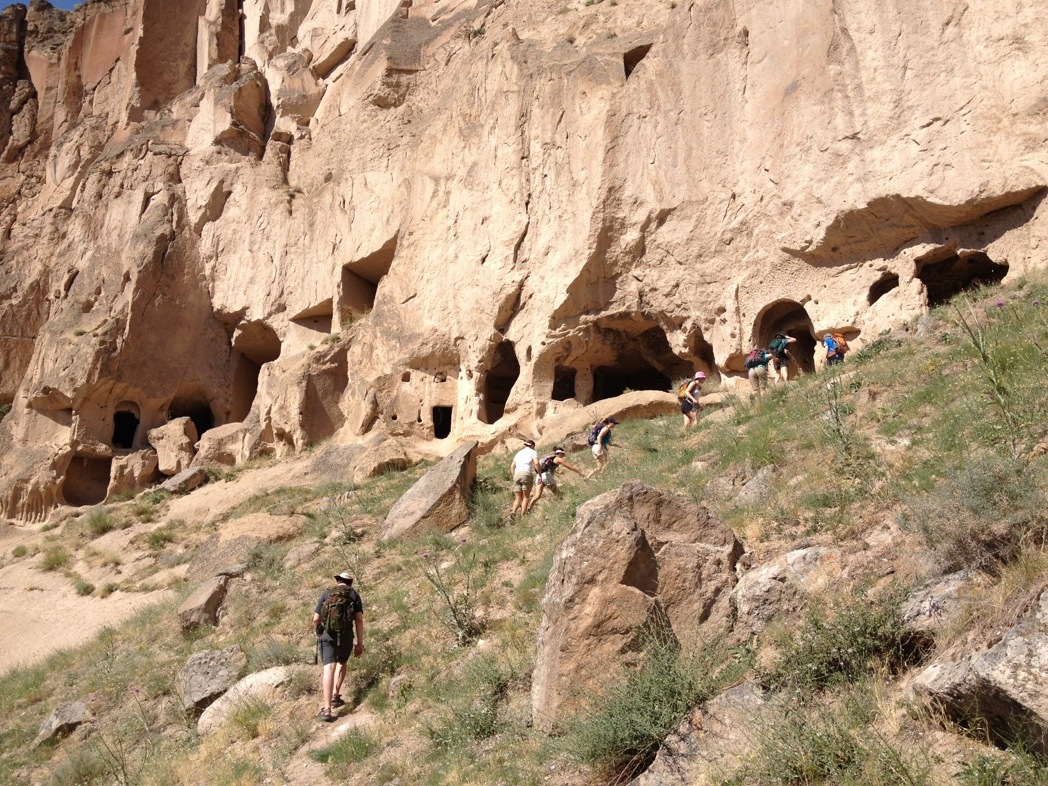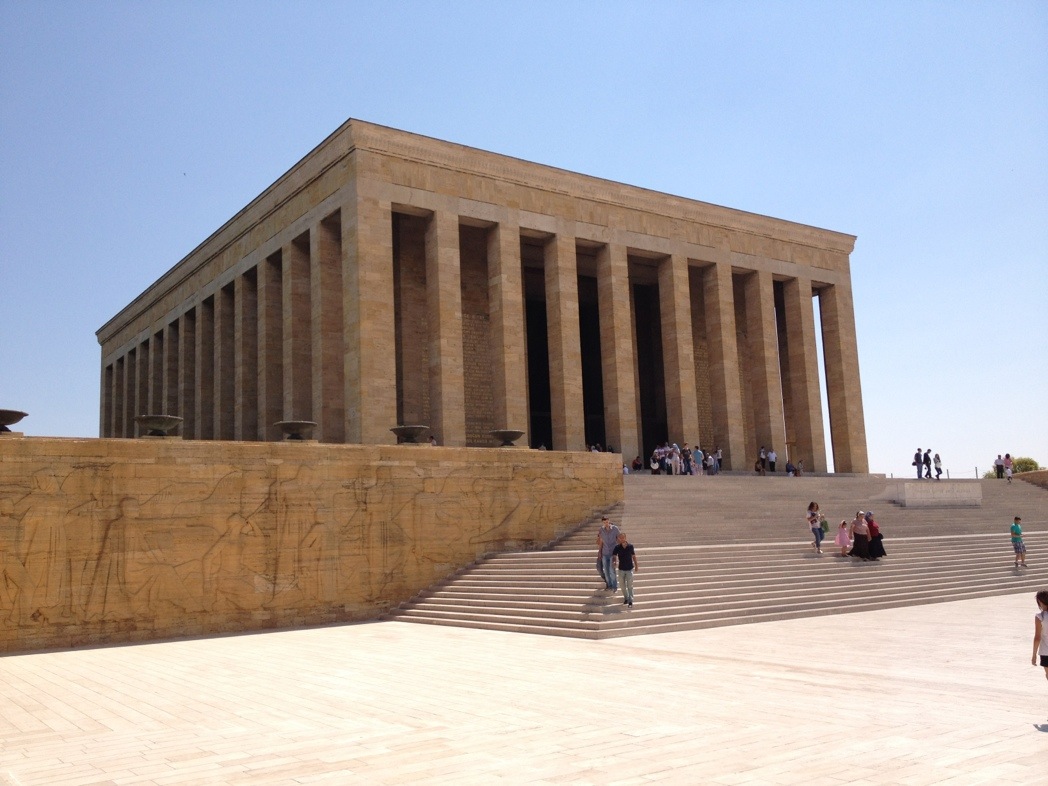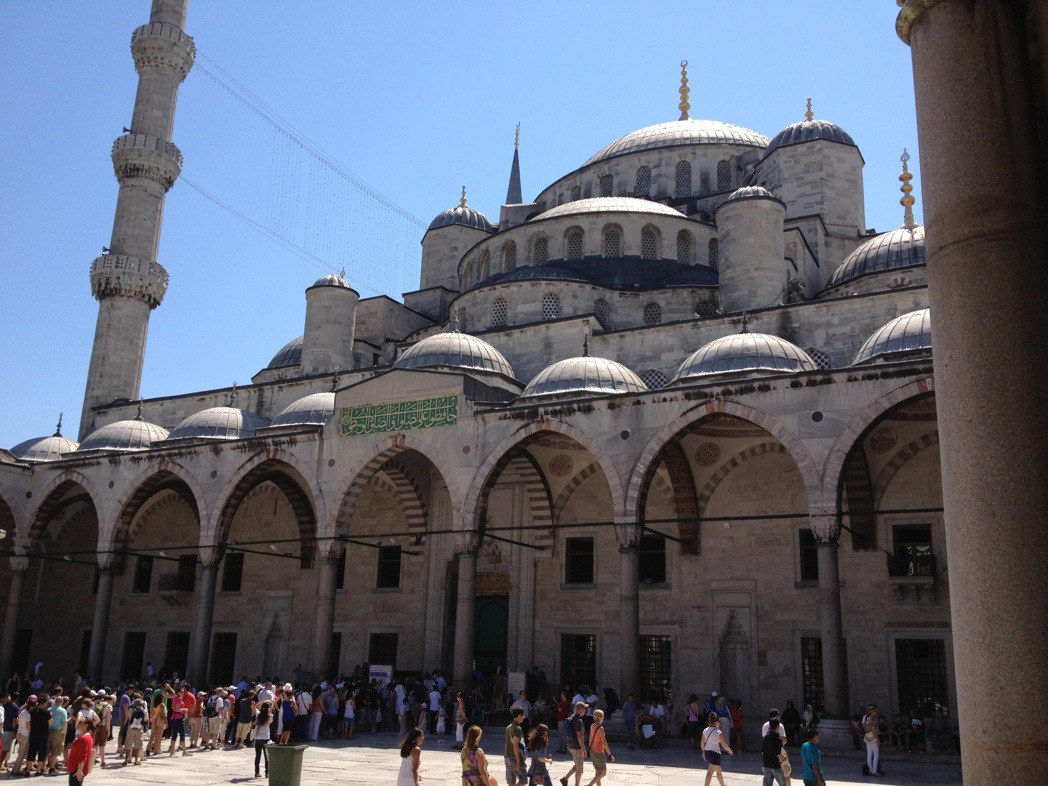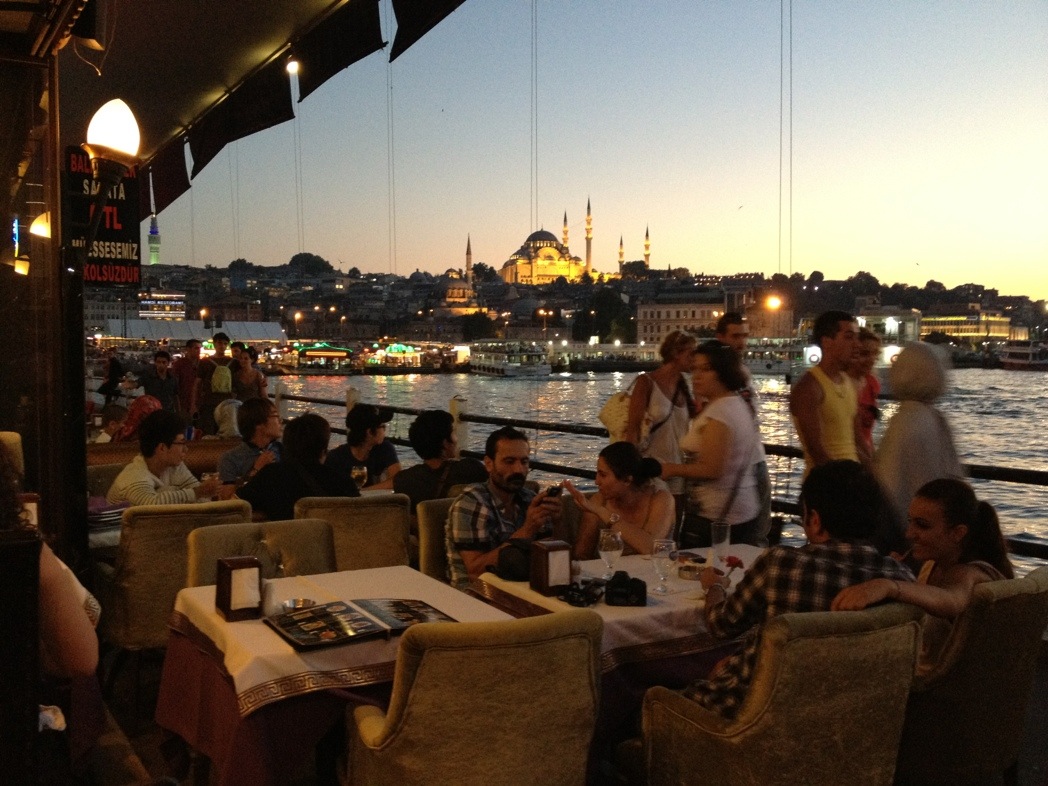The Taurus Mountains are a Turkish delight! They feature deep gorges, rock faces and crenelated ridges. To add spice to them there are a number of accessible peaks between 3000 and 4000 metres. The walking is not always easy with plenty of scree, which is fun to go down but tiresome to climb up. Thought needs to be given to the route taken to avoid some long, hot ascents; much better to descend by these long routes particularly when it is hot, and it can get very hot in July. My thermometer, attached to my camera bag, registered a high of 47C. I have by no means seen all there is of the Taurus Mountains, and I missed some of our itinerary while looking after a sick member of the group, but I have seen enough to want to return, perhaps in late spring or the autumn when the temperatures are a little more manageable.
Our introduction to the Taurus Mountains was in the village of Demirkazit with the rock wall that is Mt. Demirkazit (3756m) towering above. However, we were not there to look at the mountains but to visit the village school. The school was closed for the long summer holiday but a sizeable number of children were mustered for our visit. It was remarkably well equipped with computers and an interactive white board etc.
To break the ice we sang ‘Head, shoulders, knees and toes’ and they responded with a very loud, passionate rendition of the Turkish National Anthem. Ice broken, we handed out our goodie bags, playing with the toys in them and found out a little about them. It was all a little chaotic in the confined space of a classroom. There must have been seventy in there, adding to the already clammy atmosphere.
There were no teachers there; they were sensibly on holiday, but that was a good thing. When we asked the children what they would most like improved in their school their response was immediate and unanimous. They all wanted the toilets repaired and improved. The school caretaker, who was there, agreed with the children but also wanted the new boundary wall raised with a wire fence on top of it. With the sums done we were able to hand over sufficient funds for the two jobs to be done to everyone’s satisfaction. They have promised to send me photographs when the work is done before the new academic year starts.
Having finished at the school our bus took us the short distance to the trailhead village of Pinarbasi and the start of our Taurus Mountains trek. The walk to camp was a gentle introduction with just two hours to camp, overlooking the entrance to the Maden Valley. As we walked storm clouds brewed over Mt. Demirkazit and it started to rain. I had been the victim of much derision for carrying a small umbrella but now the rest of the group wished they had one as the majority of them, me included, had not put our waterproofs in our day sacks.
The campsite was impressively placed on a natural platform overlooking the lower end of the Maden Valley. Nearby, but not so near that the dogs disturbed us, was a nomad camp, their flocks out roaming the hillsides. These flocks are closely observed by their shepherds and protected from wolf attack by very large, often aggressive and threatening dogs. Some have spiked collars to protect them from retaliatory wolves who naturally go for the neck.
The campsite, like all the campsites we stayed in, was semi-permanent, set up for the trekking season. Occasionally we had to take down our tents in the morning so they could be moved on to the next camp but more often than not the tents were a permanent feature. It was only the large size of our group that sometimes necessitated the moving of tents. The mess tent, made of goat’s wool, was an open fronted structure with crudely, yet very effective tables and benches. The toilet tent had a porcelain squat toilet with piped water to flush it. Hose pipes from much higher up the mountain brought fresh drinking water into camp. There was even a shower tent, albeit with a hose of cold water, but even that was very welcome after a hot, sticky day.
Category Archives: Turkey 2012
Cappadocia
This region has some of the most amazing and awesome rock formations on earth. We first came across them as we approached Uchisar where there are two towers of rock sticking up out of the centre of the village. The bus then dropped over the lip of the valley and the whole panorama of rock formations lay before us. There was too much for the brain to observe and take in. Not stopping at Goreme, we continued a few kilometres to Pasabaglari, or the Valley of the Priests. Here there are numerous pillars of rock with hats of harder rock perched on the top. The soft pillars have had rooms carved into them, presumably inhabited by priests and monks.
Having explored the area we were heading back to the bus when an ice cream seller entertained the group with ice cream tricks before giving Tom Busher a free one. This was all done to encourage the rest of the group to buy from him. It would have been successful had Omer and I, not realising what was happening, summoned everybody to board the bus. The expression of disappointment on the ice cream vendor’s face was a picture to behold. The bus took us to camp in a field belonging to a hotel, which included a swimming pool as one of its assets. The hotel was largely empty as Sobek Travel had bought it with the intention of developing it but were awaiting planning permission.
The following morning I was awoken by the sound of a burner firing off close by. Knowing that balloon flights occur every morning, I opened my tent to have a look, expecting to see a couple of balloons in the air. What I saw took me completely by surprise; I counted 35 balloons! Wow! What an impressive sight. The other thing that went through my mind was, ‘I want to do this.’
After breakfast we went on a most amazing walk of about ten miles through all the best features Cappadocia has to offer. The area is abundant with ‘fairy chimneys’ or Hoodoos, which are tall, thin spires of rock that rise up from the valley floor. They are made of relatively soft rock but are capped by harder, less easily eroded stone that protects the column on which it perches.
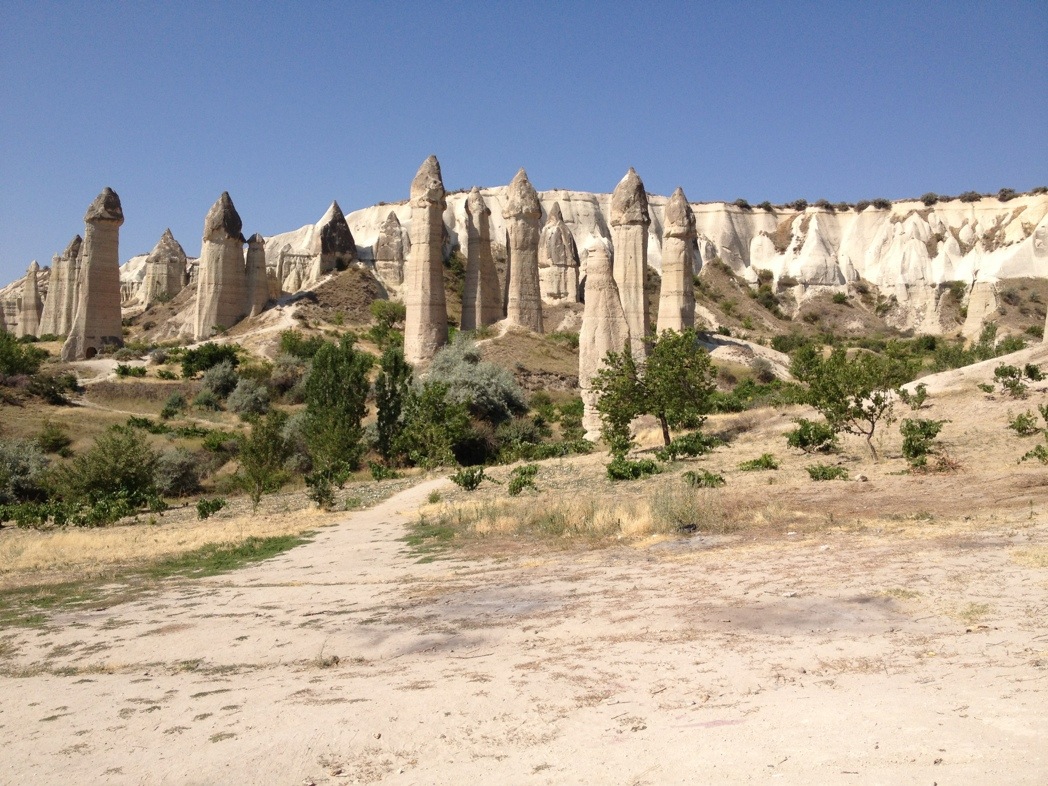
To begin with we walked through the White Valley (Akvadi), which not only has layers of white rock that bears a similarity to liquid icing that has set, but also some rather fallic formations. These caused much hilarity. The route took us through the valley bottom with all the magnificently carved rock towering above us. Eventually we climbed out, just before the village of Uchisar, to find a man under an umbrella squeezing fresh orange juice for two Turkish Lira – very welcome and much needed refreshment. Reaching Uchisar we climbed to the top of the Citadel, the huge rock rising out of and above the village. From the top there were panoramic views of the whole area. Descending, we called into a restaurant for lunch before completing our walk through Pigeon Valley back to Goreme. Pigeon Valley is so named because many of the rock pillars have been carved out for dwellings. These also had lots of small holes allowing pigeons to enter. Inside, wires were string across allowing the pigeons to roost. Every so often the droppings were collected for fertiliser, a practise that went on until the ’50s when commercial fertilisers became more available.
Goreme is a very interesting town as the houses and the fairy chimneys combine to form dwellings, restaurants and hotels. We went to such a restaurant later in the evening.
Back at camp a small group went off with Josh quad biking while another group went with Ellie for a proper Turkish bath. How they could consider such a thing after a very hot day, I cannot imagine. For the majority the lure of the pool was all they needed to keep cool and relax.
Before we left Cappadocia Jenny, Paul and I decided to take an early morning hot air balloon ride. We were picked up from camp at 4.45am and taken to the office to register and pay before being taken to the take off site. There were twenty of us in the basket, mostly Japanese, and it was a truly memorable experience. Upon take off we moved very close to one of the fairy chimneys before climbing to 1000m for the sunrise. The early morning glow on the various shades of rock was spectacular. Having climbed and drifted over the campsite and then Goreme, we dropped into Pigeon Valley, where we had walked yesterday. I was really struck by the manoeuvrability of a balloon with such a big basket. The balloon. Sprain literally steered us around trees and rock formations. Rising out of Pigeon Valley we then flew past the Citadel and beyond. It was fascinating to watch the support vehicles chasing the balloons in an effort to reach the landing sites. Our captain chose his spot and landed us very smoothly. The vehicle withe the trailer pulled up alongside. Before we were allowed out of the basket the captain lifted the balloon with a short blast from his burners and planted it gently on to the trailer. How cool is that? We climbed out to a glass of champagne and orange and a certificate.
The experience completed we climbed into the minibus for the journey back to camp. As we were to be the last to be dropped off at camp the minibus took us to parts of Goreme that we had not seen before and you could easily spend more time in this fascinating small town.
Back at camp we just had time for breakfast before embarking on the next phase of our Turkish adventure, the Taurus Mountains.
Ihlara Gorge
Leaving Ankara we travelled south to the Ihlara Gorge. En route we stopped at Tuz Golu, a huge salt lake. We walked out on to the solid surface of salt reflecting the light and heat of the sun so that it hurt. A long way beyond where we walked was clear water but if you dug a hole in the salt it soon filled with brown water.
Continuing, we again took a slight detour to see the 13th C Seljuk caravanserais, at present going through some renovation. This was strategically placed on the silk route for travellers and traders to stay and rest. There were many such places every 40km along various routes, 40km being the distance that could be covered by a camel train in a day. It is an impressive building with incredibly thick walls, designed to withstand earthquakes. I expect it will be even more impressive after the renovation work is completed.
By the afternoon we arrived at Selime and the start of our trek up the Ihlara Gorge. The approach to the village brightened up what had been scenically a rather dull and featureless journey. Above the village was a cliff made up of conical towers of rock. Unfortunately we did not stop long enough to admire them. What was to follow was well worth it. The Ihlara Gorge is a deep cleft between 300 and 500 feet deep, cut into the featureless landscape above. From above you would not know it was there until you almost fell over the edge!
We followed the small river upstream over grassy meadows, through small cultivated areas and willow trees enjoying the moisture provided by the river. The water was clear and teaming with small fish and frogs. Above the lush valley floor sandstone cliffs towered above us. There were many holes carved into them where ancient cave dwellers had once lived. These were often monks and hermits but they would also give good protection during conflict as well as the advantage of height over any would be attacker. We visited a number of these dwellings which provided cool respite from the heat of the afternoon. Something we spotted several times, which carry their own cooling house, we’re tortoises – an unexpected bonus.
After a cooling paddle in the river we soon reached camp in Belsirima village. There we could relax on canopied platforms built over the river with thick cushions to lounge on. The fast running water inches below us helped to cool the air around us making it very pleasant. The night was spoilt by dogs constantly barking and two pups decided to tear a fly sheet to shreds, much to the concern of the occupants.
If we thought the first day in the Ihlara Gorge was impressive, the second was more so. Remarkably dozens of churches were carved into the rock cliffs and we visited a couple of them. Not only were they carved into the rock but the walls and ceilings were painted with frescos.
Just before we came to the top of the gorge the river tumbled over a waterfall into a plunge pool. Ten foot cliffs arched around the pool, which proved to be deep enough for jumping in to. We spent a good hour enjoying the opportunity to get cool and the students became ever more inventive in the way they leapt into the water.
The bus was waiting for us and took us back to Selime for lunch, a feast enjoyed more by the swarms of wasps, which spoilt an otherwise excellent meal. After lunch we drove to Goreme in the heart of Cappadocia and the site of some incredible rock formations.
Ankara
A short flight took us from Istanbul to Ankara, the capital of Turkey. The history is quite interesting. Until 1922 Istanbul was the capital but when Ataturk created the modern Republic of Turkey in 1922 he wanted to move the capital to somewhere more central, which was seen to represent all of the people. Ankara only had a population of 10,000 in 1922 but quickly grew under its new status. It continues to grow today and has population of 4.5 million. Although Istanbul has a population of 13 million, Ankara covers a much larger area. This was clear as we drove from the airport, quite some distance from the city, and witnessed massive housing and commercial development taking place.
Our first afternoon in Ankara was free so we set about exploring the areas we could reach by walking. The shopping area was like many others in big cities but it was made more attractive with trees offering shade from the fierce sun above. We found ourselves in a park but it seemed to be a waste of valuable time in a new city to languish in a park, even though we did enjoy playing on the outdoor fitness equipment. Heading back towards the hotel we found ourselves in an open air bar and enjoyed watching people go about their daily lives over a beer or two.
On our second day we had plans to visit the Mausoleum of Ataturk, a huge area on top of a hill with a great deal of extravagance. Ataturk is extremely highly regarded as the founder of modern Turkey and, as such, this is clearly as sign of the respect the nation holds for him. The museum gives detail of the history of the development of modern Turkey but there was just too much to take in.
From there we went to Ankara Castle, part of the defensive fortifications of the old, much smaller city. On arrival we had lunch in a wonderfully rustic restaurant inside the castle walls and it was a superb meal served by a portly chef who was not only extremely efficient but also spoke excellent English.
The castle is a bit run down and some of the houses inside are falling down. What it did do was afford us a wonderful view of the whole city as it spreads out over numerous hilltops.
Later we returned to the same bar to watch the world go by. I couldn’t help notice and mention that we had seen very few overweight people in Turkey and that everybody is smart. It must be something to do with the climate suppressing their appetites. It doesn’t seem to be doing that with mine!!
I didn’t enjoy Ankara as much as Istanbul. It is much too spread out and the traffic seems to be constantly gridlocked. I enjoyed the relaxation and the people watching but it is not a city I would rush back to, whereas Istanbul has a much greater attraction.
Istanbul
With only a day to enjoy the sights of Istanbul we wanted to make the most of the time we had. The hotel was very conveniently placed so that nothing was very far away. Our first port of call was the Hippodrome, a large area of learning and religion. To one side is a large church converted to a mosque, but now a museum, on the other the Blue Mosque. Dodging from one shady spot to another, Omer, our guide, filled us in on some of the history of Istanbul before we entered into the relative cool of the Blue Mosque, a huge domed prayer house. From there we slowly meandered down to the water front where we bought bread and fish before boarding a boat to take us around the Bosporus. The cool breeze generated by the movement of the boat was most welcome. As we turned to return we had dolphins leaping out of the water alongside out boat.
At 5.00pm we went to explore the spice market, a lively, friendly place with banter and not too much pressure to buy. Having explored I went back to the stalls I had enjoyed most and bought a variety of teas from one stall and spices with a spice grinder from another.
In the evening we went down to the water front for a superb meal as the sun set over the Bosporus.



